The first Chancellor of the Federal Republic of Germany
The European Union we live in now is built on the ideas of a number of visionaries from a variety of different backgrounds. They were able to build an area of peace thanks to their tireless commitment to unity, democracy, pacifism and prosperity. One of the founding fathers had a profound impact on the history of his country, and therefore also on Europe too. His name was Konrad Adenauer.
He was born into a modest Catholic family in Cologne on 5 January 1876. Like many others Europeans who were instrumental to these institutions, he chose a career in law and economics. But that wasn’t what brought him and his future wife together, however: they met at a tennis club in 1901. They married three years later, and it was through his wife’s family that he managed to break into the closed world of politics, first of all in Cologne city council.
Talented and tenacious
A man of ideas and commitment, he became Mayor of Cologne in 1917. At the time he was the youngest person ever to hold such an office in Prussia and he obviously shone at it, as he was lauded by his peers for his determination and tenacity in tackling large-scale projects such as the very first German Autobahn linking Bonn with Cologne.
Adenauer was known for his aversion to extremes, which caused him problems under the Nazi regime. It also practically ruined him, at least initially. In 1933, after the Nazis had seized power, Adenauer openly snubbed Hitler by refusing to decorate the city with swastikas for a visit by the Führer. That ‘mistake’ cost Adenauer his job. His bank accounts were frozen and he found himself on the street, unemployed and penniless, and it was only thanks to his friends and the Church that he got through the war.
He was arrested on a number of occasions and was briefly imprisoned on the Night of the Long Knives in 1934, when the SS took over. Later, after the attempt on Hitler’s life on 20 July 1944, Adenauer was held in the notorious Gestapo prison at Brauweiler, near Cologne, until November of that year.
The comeback
After the war Adenauer was once again installed as Mayor of Cologne, with the support of the Americans. Afterwards, however, control of the city was transferred to the British. They were loath to trust someone who they saw as a ‘reactionary Catholic’, and sacked him. It was then that he devoted himself to setting up the Christian Democratic Union (CDU). In 1949, he became the first Chancellor of the Federal Republic of Germany (West Germany). Despite his ‘great’ age (he was 73), Adenauer – who was known as Der Alte (‘the Old Man’) – would remain in post for 14 years. Now at the height of his powers, Adenauer thought that foreign policy would become increasingly important.
The two world wars had had a profound impact on Adenauer, who worked throughout his life to establish democracy. Seeing Germany economically, politically and morally ruined, he was convinced that taking the country into the community of Western European Christian democracies would solve its post-war problems. It was also thanks to him that West Germany became a member of NATO. A fervent supporter of the European Coal and Steel Community set up after the Schuman Declaration of 9 May 1950, Adenauer backed the European Defence Community project, and then the Treaty of Rome, which established the European Economic Community and Euratom in 1957.
 Konrad Adenauer, former German Chancellor, and one of the Founding Fathers of the European Union died on April 19, 1967. © European Union 1989 – European Parliament
Konrad Adenauer, former German Chancellor, and one of the Founding Fathers of the European Union died on April 19, 1967. © European Union 1989 – European Parliament
The greatest
Adenauer’s take on Europe was simple: only European unification would prevent a return to the disastrous wars that had set brother against brother in the past. He fought for the reunification of Germany, and for reconciliation with the country’s old enemies, especially France. In 1963, he finally got what he wanted: the Elysée Treaty – also known as ‘the Treaty of Friendship’ – sealed the reconciliation between France and Germany, ending the age-old rivalry between the two powers. Adenauer succeeded in restoring the prestige of a country so tarnished by the extremism that had brought it to its knees.
A historian wrote: "Konrad Adenauer is one of the most prominent figures in the history of Europe. For him, European unity was not only a guarantee of peace, but also a way of bringing post-Nazi Germany back into the international fold. Europe as we know it would never have come about without the trust he inspired among other European states with his consistent foreign policy. His actions are still recognised by the German public who, in 2003, voted him ‘the greatest German of all time".
The Adenauer building is also Parliament’s largest: after the new wings were opened in 2020, the building that houses all the departments based in Luxembourg has a surface area of some 250, 000 m².